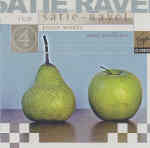As a Ravel interpreter, Anne Queffélec cultivates the brilliantly articulated, finger-oriented style we often associate with the French school of pianism. Her bright projection and dry touch vivify Le Tombeau de Couperin’s linear logic, while the Valses nobles et sentimentales takes on a gaunt, straightlaced quality that happily bypasses more than eight decades of mannerisms. Yet in all of Miroirs’ superbly etched fingerwork there’s not much color or dynamic contrast (Noctuelles’ pianissimo filigree is way too loud, for instance). The Sonatine, Jeux d’eau, and Gaspard de la nuit go by the book, but without the color and character that distinguish the catalog’s best Ravel recordings.
But when it comes to her judicious cross-section of Satie’s “greatest hits” plus, Queffélec’s an utterly different pianist–and a far more imaginative one at that. Her tone ripens and expands, replete with telling rubatos that read between the composer’s cryptic lines without ever obliterating the message. I love, for example, Queffélec’s way of caressing the Pièces Froides’ loping arpeggios, the gorgeous textural differentiation she brings to the Descriptions automatiques, and the purity of line that keeps the beloved Gnossiennes and Gymnopédies afloat. In addition, Catherine Collard joins Queffélec for vibrant readings of the Trois morceaux en forme de poire and La Belle Excentrique. My performance rating reflects a compromise between 6 for Queffélec’s uneven Ravel and 10 for her magnificent Satie.
































